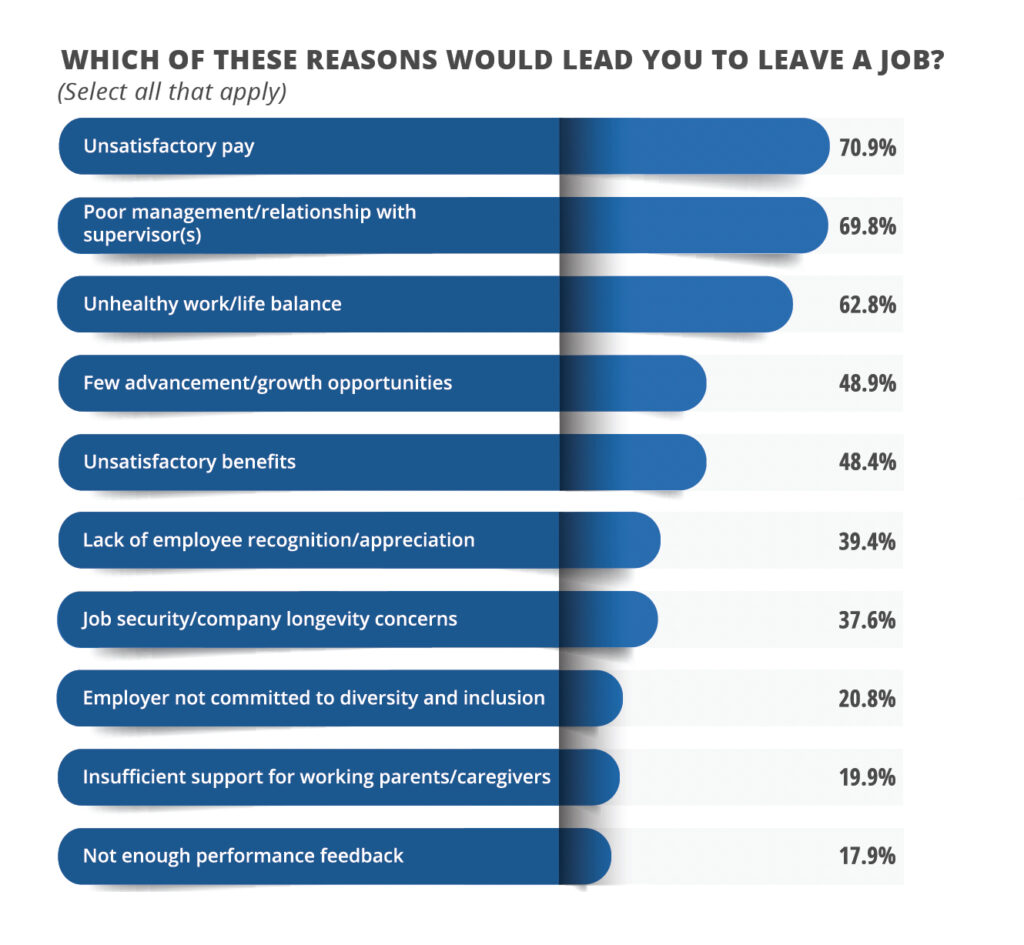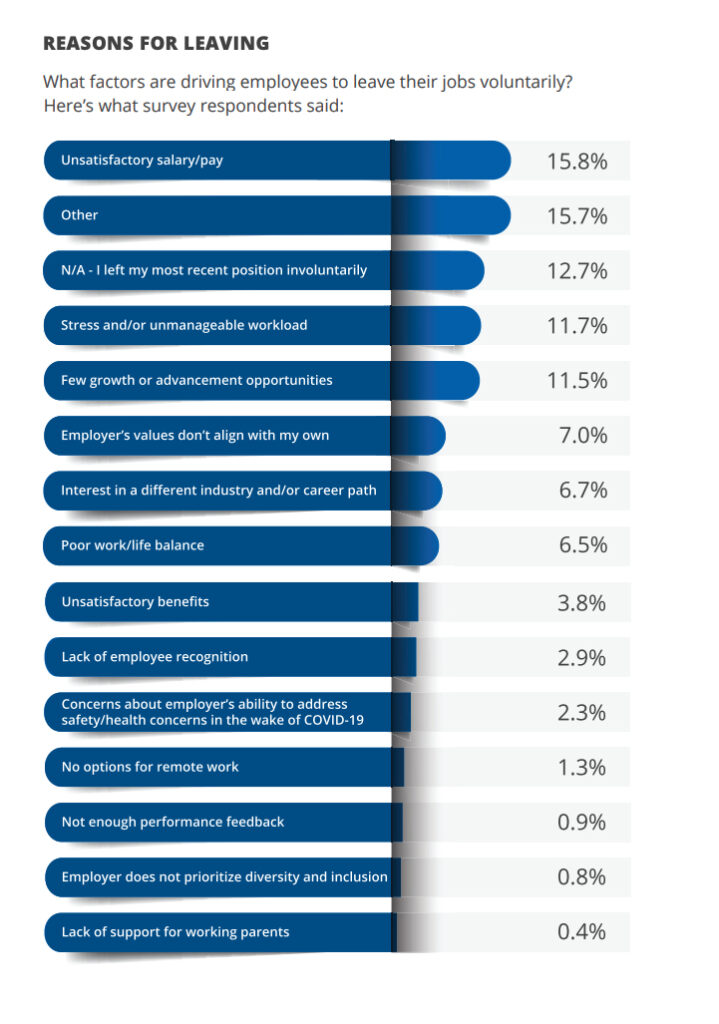According to the Bureau of Labor Statistics, the number of Americans who voluntarily quit their jobs in August and September 2021 were record breaking. In August, 4.3 million employees resigned and in September, just reported this past Friday, an additional 4.4 million did as well. The last time a record exodus of this magnitude occurred was in December of 2000. We believe we have some answers and can help retain engaged employees who are committed to your organization for the long haul.
A recent Talent Retention Report performed by iHire* offers insights about retention trends and, more importantly, how to keep your talent engaged, motivated, and committed to your Company.
3,948 workers from 57 industries were surveyed in October 2021. They were asked the following questions:
- Have you left a job voluntarily in the past year?
- Have you made a significant career change in the past year?
- How satisfied are you in your current job?
- Which COVID-19-related reasons would lead you to leave your job?
- What would cause you to leave your job?
- What, specifically, could your employer offer to convince you to stay if you were considering taking another job?
You can access the full survey results here. In this blog, we are going to look at the results to the question: “What would cause you to leave your job?” and offer some tips on how to address the top 3 reasons that were reported.
What we know to be true is that recruiters are reaching out to your employees as we speak. If you want to retain your top talent, here’s what the survey revealed about why employees would leave a company.

2021 Talent Retention Report Results
While money is often the reason given for leaving, it is not always the REAL or the only reason(s). It is important that you know how your compensation and benefits measure up against your competition and similar positions in your geographic area. Doing a salary survey right now would be a good idea because many companies have had to pay more for key positions and what was average pay for positions, even 6 months ago, has changed and will continue to adjust in the months to come.
Make sure that your more tenured talent is compensated appropriately and feels taken care of—nothing is worse for an employee who’s been contributing for years to a team/company to discover that new hires are making more.
If your compensation is competitive, then the REAL reason for an employee to look for another position probably lies in the remaining responses. Note that reasons #2, poor management, and #3, unhealthy work/life balance, are significant when compared to last year’s 2020 Talent Retention Report where these two items were ranked substantially lower.

2020 Talent Retention Report Results
Poor management and an unhealthy work/life balance are key elements of a company’s culture, and these results lead us to offer some questions for your consideration:
- Do you know how your managers/leaders impact their employees? Are your managers/leaders successful at motivating, managing, and coaching your top talent? Do they have a high level of Emotional Intelligence?
- Are your managers perceived as ineffective or poor managers by their employees? What is their internal brand within the company? Are they both liked and respected?
- Does your culture allow for poor managers to overstay in their positions? Are you at risk of losing top talent due to underperforming/underwhelming management?
- What is the company’s definition of a successful manager? How do you monitor a manager’s performance against this definition? Where and how are you getting objective feedback on your managers?
- What messages are sent by management about work/life balance? Do your words match the expectations you have of your employees? Do all your managers’ actions match the company’s statements about work/life balance? Mangers who demonstrate their worth by working way too many hours a week, and are themselves burnt out, send a message of what is required. Is that what you really want?
If you find it difficult to answer these questions, it’s time to get to work and begin answering them. Top talent isn’t going to wait for you to figure it out!
Here are some immediate next steps we recommend:
- At your next leadership team meeting, develop a list of your top talent in the organization (by department) and develop strategies for ensuring that every individual on that list has a relationship with at least 3 other leaders in the organization. Top talent who are highly connected with leadership are likely to be more committed to the organization. Quality relationships are key to retention and to fulfilled employees.
- If you haven’t done an assessment of your managers, yesterday was the time to do it. Don’t wait. If you are removed from the day-to-day interactions between managers and their team members, it is important that you have a way to gather this information. The most effective managers seek out feedback from their team members. If your managers are resistant to getting feedback, pay attention!
Bring your management team together and develop a definition of a successful manager in your organization. Publish this definition (we call them Leadership Commitment statements) so that all employees know how their manager’s success is being measured. For extra points, include top talent in the development of the criteria. - Every leader, manager, and employee may have a different definition of work/life balance, and this causes conflicting and confusing messaging about the organization’s definition of work/life balance. Given that 62.8% of the respondents listed work/life balance as the reason they left an organization, organizations need to get ahead of this trend and clearly define what work/life balance means and looks like in their organization. Leaders and managers need to be on the same page about what it is and isn’t. Most importantly, they need to not only be modeling it, they also need to be talking with their team members about what their team members’ definition is and how it aligns—or doesn’t—with the organization’s definition. Open dialog is the way to go here.
In a recent survey by Oxford Economics, almost half of respondents said they would leave for a lower paying position at a company with a better organizational culture.
As we consider these trends and this data, we’re thrilled to say the companies we’re working with are retaining their top talent and continuing to create healthy and effective work cultures. If you want to know how to do it or realize that now is the time to make progress on this, reach out—we’re happy to talk.
*iHire 2021 Talent Retention Report, 3rd Annual Addition




